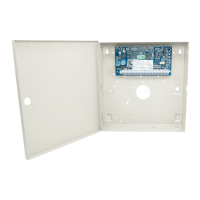Section 5: Programming
Wireless Zone Low Battery Transmission Delay (in days)
When a zone reports a low battery condition, the trouble is indicated immediately on the keypad, but the transmission to the
monitoring station is delayed by the number of days programmed in this section. If the low battery condition is not corrected
before the delay expires, the low battery condition is transmitted. The Low Battery Restore transmission is not delayed.
Delinquency Transmission Delay
The value in this section determines the period of time before a delinquency event is generated.
Delinquency delay is measured in days if using closing delinquency or hours if using activity delinquency as programmed in
section [311] option 6. Valid entries are [001]-[255] or [000] to disable.
Communications Cancel Window
After the transmission Delay expires and a zone alarm is transmitted, the communications cancel window begins.
If an access code is entered during this window, a reporting code is communicated and logged. If the window expires
without an access code entry or a code is entered after the window, the communications canceled event is not logged or
communicated.
Note: The cancel window does not start after an [F][M][P] key alarm.
[003] – Periodic Test Transmission Cycle
This value determines the period between test transmissions. Valid entries are [000]-[255]. Whether this interval is in hours
or days is determined by section [022], option 4.
Note: For UL/ULC listed installations, the test interval is 24 hours.
[004] – Periodic Test Transmission Time of Day
Enter a 4-digit time using the 24-hour clock format (HH:MM).
Valid entries are from 00 to 23 for the hours (HH) and 00 to 59 for the minutes (MM).
To disable the test transmission time of day, enter [9999] in this section.
Note: This time should not be set for the same time as Day Light Savings time.
[011] – Maximum Dialing Attempts
This section is used to program the number of dialing attempts made to each telephone number when communicating. Valid
entries are 002-005.
Note: For UL/ULC listed installations, this value must be set to 005.
[012] – Delay Between PSTN Attempts
This programmable timer adds a delay before the next call is attempted over PSTN. Valid entries are 000-255, with a default
of 3 seconds (making a total of 8 seconds: 3-second delay + standard 5-second dial tone search).
[013] – Delay Between Force Attempts
This programming option is used to set the length of time the alarm system waits between the first dialing attempt and the
force dial attempt.
Valid Entries are 001-255 seconds. Default is 020.
[014] – Post Dial Wait for Handshake
This option is used to program the length of time the communicator waits for a valid initial handshake from the receiver after
dialing the programmed telephone number. Valid entries are 001 to 255 seconds.
Note: Maximum 45 seconds for UL installations.
[015] – T-Link Wait for Ack
This option is used to program the length of time the communicator waits for an acknowledge after transmitting via IP/GS.
Valid entries are 001 to 255. Default is 60 seconds.
[016] –IP/Cellular Fault Check Timer
This section is used to program the number of poll commands sent without valid poll responses before the alarm system gen-
erates a trouble condition. The checks occur at 3-second intervals.
Valid entries are 003-255 for trouble annunciation and transmission.
The trouble restore is not delayed.
- 109 -

